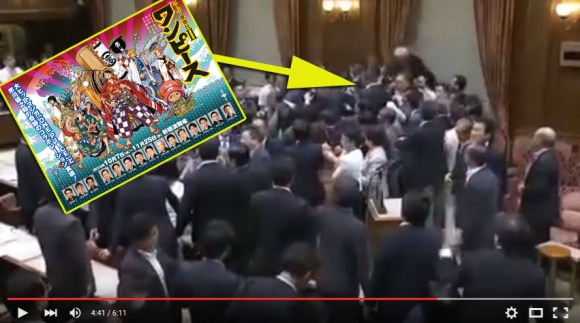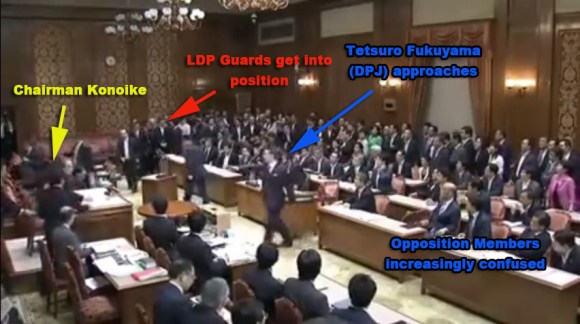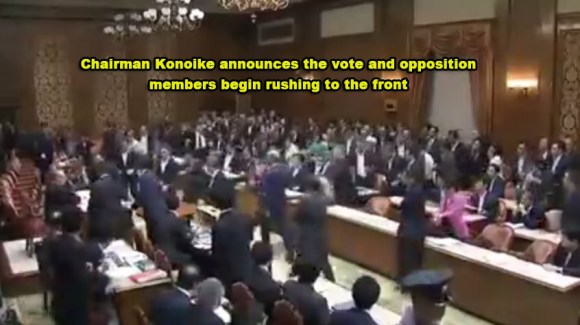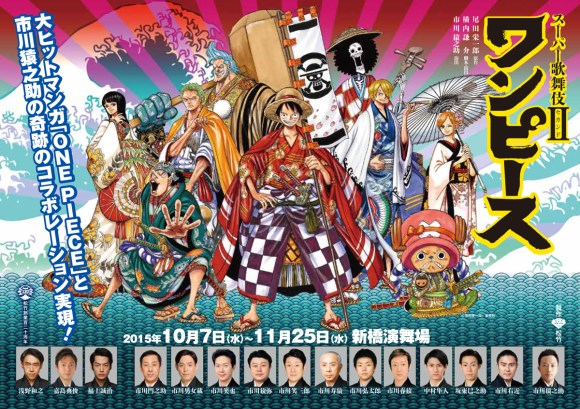
The above scene of Japanese elected officials climbing on top of each other like extras in a Pearl Jam music video made headlines worldwide much to the country’s chagrin. And it was in this way that Japan has officially reinterpreted its constitution to allow military deployment to other parts of the world for the first time since World War II.
Yes, rather than through persuasive speech and the rational debate that government was designed to produce, the future course of Japan had been steered by underhanded tricks, shoving matches, and even a decoy legislation made of a One Piece advert.
But were these uncivilized tactics motivated by honest passion and the sheer intensity of the situation, or were the elite of Japanese society simply showing their true nature of political impotence? To find out, let’s take a look at how the whole fracas started.
■ Stacked deck
Up until the events of the past week, the Japanese Diet spent over 200 hours debating the proposed changes to Japan’s policy of pacifism. After passing through the Lower House, dominated by Abe’s Liberal Democratic Party (LDP), it went for further deliberation and final approval to the Upper House, which also has a majority of LDP members.
By the numbers alone, it was a foregone conclusion that the bills would be approved. However, emboldened by large-scale protests and surveys suggesting a majority of citizens were against the bills, the opposition parties decided to take unorthodox actions to buy some time.
■ Hell no, Konoike won’t go!
On 16 September, a committee was called to discuss the security bills. However, it was widely assumed that the discussion would be concluded and voting would take place that evening to send the bills for their final vote in the Upper House. With a holiday weekend approaching, there was a high chance that protester numbers could swell greatly and weaken the LDP’s momentum.
So, in an effort to stall the vote, a group of opposition party members, made up mostly of women wearing pink headbands, picketed a room containing the committee chairman Yoshitada Konoike, trapping him inside. Since he was unable to attend, the meeting was unable to start, and so no vote occurred that night.
However, as Prime Minister Abe sat in the empty chamber until the wee hours of the morning arms folded and head nodding, Konoike was busy plotting his revenge…and possibly napping as well.
■ Konoike strikes back
The chairman concocted a scheme that was called “Konoike’s Coup D’Etat” by other party members. The first step was to call another session on the afternoon of Friday, 17 September. However, the purpose of this meeting was not to discuss the security bills but a motion of no-confidence against Konoike himself, which had been put forward by opposition members to further gum up the works.
Opposition party members believed this and let the committee meet, because even if they could stall the vote longer, it would still eventually return to the Lower House who could pass the bills all by themselves under what is called the “60-Day Rule.”
And so, feeling as if they had won the day, the weary opposition members showered up and got ready for another session at 4:00 p.m.
■ The stage was set
Chairman Konoike walked into the chamber and bowed to all in attendance before taking his seat. Then Democratic Party of Japan (DPJ) member Tetsuro Fukuyama began to walk towards Konoike asking what was on the agenda.
Just then, about 10 or so LDP lawmakers surrounded Konoike forming a protective barrier much like an offense line around a quarterback. Opposition members stared at the formation in a brief moment of confusion until Konoike began telling them what was really about to take place.
Several opposition members ran towards the chairman’s seat in the hopes of finding some way to stop the vote from commencing. Meanwhile, LDP member Masahisa Sato who was standing near Konoike gestured to Ichita Yamamoto to start the proceedings. Yamamoto announced that deliberation for the security bills was officially closed and voting would commence immediately.
■ One Piece in the hole
All that was left was for Konoike to read aloud the bills and instructions for voting. It was determined the night before that it would take about a minute and a half, during which the LDP offensive line would have to hold back the attacking waves of opposition members to successfully start the vote.
DPJ member Hiroyuki Konishi nearly broke through by climbing over the rear of the LDP phalanx and trying to snatch the paper Konoike was reading from. However, he was easily pushed away by a slow-motion punch from Sato. Primer Minister Abe, who was sitting a few seats away, made a quiet exit once he saw the plan was working.
▼ Sato is the mustachioed gent with the slow hand
Regardless of whether Konishi could have made it to the paper, Konoike had proven himself to be a truly cunning legislator. Prior to entering the chamber he had placed a pamphlet for the kabuki adaptation of the hit manga One Piece in his pocket. In the event any opposition member could penetrate his offensive line, he could swap out the legislation with the One Piece ad and continue to open the vote.
▼ One Piece ad or constitution changing bill? Who can tell…
In the end, Konoike made it through the reading, even though no one actually could hear him over the shouting and chants of “Muko!” (Does not count!). And the security bills were moved on to an Upper House vote of 148 to 90 during a plenary session. And that’s how the future of Japan was changed.
Ultimately, history will be the judge on whether these bills were the right move or not for the country. All I know is if I were the manager of a McDonald’s and this group of politicians were my crew, they’d all have been fired on the spot.
And yet, here they are, continuing to run Japan.
Source: Asahi Shimbun Digital, Sankei News, Hachima Kiko (Japanese)
Videos & Images: YouTube/TBS News-i, YouTube/nihon1740, VINE/しーなP@Fate/Go始めました
One Piece Flyer Image: Kabuki-bito





 Should Japan become the next Vegas or Macao? 57% of Japanese people say “no thanks” in new survey
Should Japan become the next Vegas or Macao? 57% of Japanese people say “no thanks” in new survey Japanese politician scraps plan to use Animal Crossing for political campaign tour
Japanese politician scraps plan to use Animal Crossing for political campaign tour “Protect the Nation from NHK Party” becomes “Protect the Nation from Old Parties Party”
“Protect the Nation from NHK Party” becomes “Protect the Nation from Old Parties Party” Japanese parliament descends into utter chaos, shouting match over proposed water law【Video】
Japanese parliament descends into utter chaos, shouting match over proposed water law【Video】 Leadership does nothing despite public harassment of Tokyo Metropolitan Assembly member
Leadership does nothing despite public harassment of Tokyo Metropolitan Assembly member McDonald’s new Happy Meals offer up cute and practical Sanrio lifestyle goods
McDonald’s new Happy Meals offer up cute and practical Sanrio lifestyle goods All-you-can-drink Starbucks and amazing views part of Tokyo’s new 170 meter-high sky lounge
All-you-can-drink Starbucks and amazing views part of Tokyo’s new 170 meter-high sky lounge More foreign tourists than ever before in history visited Japan last month
More foreign tourists than ever before in history visited Japan last month Starbucks reopens at Shibuya Scramble Crossing with new look and design concept
Starbucks reopens at Shibuya Scramble Crossing with new look and design concept Beautiful Sailor Moon manhole cover coasters being given out for free by Tokyo tourist center
Beautiful Sailor Moon manhole cover coasters being given out for free by Tokyo tourist center Studio Ghibli glasses cases let anime characters keep an eye on your spectacles
Studio Ghibli glasses cases let anime characters keep an eye on your spectacles Tokyo luxury hotel offers month-long stays with free breakfasts, might be cheaper than apartment
Tokyo luxury hotel offers month-long stays with free breakfasts, might be cheaper than apartment Mister Donut ready to make hojicha dreams come true in latest collab with Kyoto tea merchant
Mister Donut ready to make hojicha dreams come true in latest collab with Kyoto tea merchant Hamster abandoned at Tokyo ramen restaurant gets new home
Hamster abandoned at Tokyo ramen restaurant gets new home Inflation making penguins in Japan unhappy with aquarium’s switch to cheaper fish
Inflation making penguins in Japan unhappy with aquarium’s switch to cheaper fish Disney princesses get official manga makeovers for Manga Princess Cafe opening in Tokyo
Disney princesses get official manga makeovers for Manga Princess Cafe opening in Tokyo Beautiful new Final Fantasy T-shirt collection on the way from Uniqlo【Photos】
Beautiful new Final Fantasy T-shirt collection on the way from Uniqlo【Photos】 Is the new Shinkansen Train Desk ticket worth it?
Is the new Shinkansen Train Desk ticket worth it? Foreign English teachers in Japan pick their favorite Japanese-language phrases【Survey】
Foreign English teachers in Japan pick their favorite Japanese-language phrases【Survey】 Japanese convenience store packs a whole bento into an onigiri rice ball
Japanese convenience store packs a whole bento into an onigiri rice ball We try out “Chan Ramen”, an underground type of ramen popular in the ramen community
We try out “Chan Ramen”, an underground type of ramen popular in the ramen community Studio Ghibli releases Kiki’s Delivery Service chocolate cake pouches in Japan
Studio Ghibli releases Kiki’s Delivery Service chocolate cake pouches in Japan Japan’s bone-breaking and record-breaking roller coaster is permanently shutting down
Japan’s bone-breaking and record-breaking roller coaster is permanently shutting down New definition of “Japanese whiskey” goes into effect to prevent fakes from fooling overseas buyers
New definition of “Japanese whiskey” goes into effect to prevent fakes from fooling overseas buyers Our Japanese reporter visits Costco in the U.S., finds super American and very Japanese things
Our Japanese reporter visits Costco in the U.S., finds super American and very Japanese things Studio Ghibli unveils Mother’s Day gift set that captures the love in My Neighbour Totoro
Studio Ghibli unveils Mother’s Day gift set that captures the love in My Neighbour Totoro Foreign passenger shoves conductor on one of the last full runs for Japan’s Thunderbird train
Foreign passenger shoves conductor on one of the last full runs for Japan’s Thunderbird train Domino’s Japan now sells…pizza ears?
Domino’s Japan now sells…pizza ears? New Japanese KitKat flavour stars Sanrio characters, including Hello Kitty
New Japanese KitKat flavour stars Sanrio characters, including Hello Kitty Kyoto creates new for-tourist buses to address overtourism with higher prices, faster rides
Kyoto creates new for-tourist buses to address overtourism with higher prices, faster rides Sales of Japan’s most convenient train ticket/shopping payment cards suspended indefinitely
Sales of Japan’s most convenient train ticket/shopping payment cards suspended indefinitely Sold-out Studio Ghibli desktop humidifiers are back so Totoro can help you through the dry season
Sold-out Studio Ghibli desktop humidifiers are back so Totoro can help you through the dry season Japanese government to make first change to romanization spelling rules since the 1950s
Japanese government to make first change to romanization spelling rules since the 1950s Ghibli founders Toshio Suzuki and Hayao Miyazaki contribute to Japanese whisky Totoro label design
Ghibli founders Toshio Suzuki and Hayao Miyazaki contribute to Japanese whisky Totoro label design Doraemon found buried at sea as scene from 1993 anime becomes real life【Photos】
Doraemon found buried at sea as scene from 1993 anime becomes real life【Photos】 Tokyo’s most famous Starbucks is closed
Tokyo’s most famous Starbucks is closed One Piece characters’ nationalities revealed, but fans have mixed opinions
One Piece characters’ nationalities revealed, but fans have mixed opinions We asked a Uniqlo employee what four things we should buy and their suggestions didn’t disappoint
We asked a Uniqlo employee what four things we should buy and their suggestions didn’t disappoint Princesses, fruits, and blacksmiths: Study reveals the 30 most unusual family names in Japan
Princesses, fruits, and blacksmiths: Study reveals the 30 most unusual family names in Japan Citizens group protests Japanese city council that kicked woman out for using cough drop
Citizens group protests Japanese city council that kicked woman out for using cough drop Man in charge of cybersecurity for 2020 Olympics has never touched a computer
Man in charge of cybersecurity for 2020 Olympics has never touched a computer Japanese politician apologizes for saying serial killer was “heavily influenced by anime”
Japanese politician apologizes for saying serial killer was “heavily influenced by anime” Japan passes law requiring efforts for equal number of male and female candidates in elections
Japan passes law requiring efforts for equal number of male and female candidates in elections Ukraine’s message of thanks and friendship gets really awkward with Japan
Ukraine’s message of thanks and friendship gets really awkward with Japan Japanese prime minister accidentally asked about government’s massive “Robbery Campaign” budget
Japanese prime minister accidentally asked about government’s massive “Robbery Campaign” budget LDP deems gay rights legislation ‘unnecessary’ according to multi-party survey
LDP deems gay rights legislation ‘unnecessary’ according to multi-party survey Did Prime Minister Abe just make an entire protest disappear?
Did Prime Minister Abe just make an entire protest disappear? Friending Japan’s Liberal Democratic Party will get you free Shinzo Abe stamps for Line messenger
Friending Japan’s Liberal Democratic Party will get you free Shinzo Abe stamps for Line messenger Japan’s prime minister wants to make it illegal for parents to hit kids when disciplining them
Japan’s prime minister wants to make it illegal for parents to hit kids when disciplining them Japanese finance minister is in hot water after statement allegedly condoning Hitler
Japanese finance minister is in hot water after statement allegedly condoning Hitler Hayao Miyazaki speaks out against relocation of Okinawa U.S. base, criticizes Prime Minister Abe
Hayao Miyazaki speaks out against relocation of Okinawa U.S. base, criticizes Prime Minister Abe Artist Takashi Murakami immortalises heckled Tokyo assembleywoman in dot-art portraits
Artist Takashi Murakami immortalises heckled Tokyo assembleywoman in dot-art portraits Japanese politicians boycott meetings for being told they should wear ties when they didn’t have to
Japanese politicians boycott meetings for being told they should wear ties when they didn’t have to Japan’s prime minister asks men cheating on their wives, and their girlfriends to vote for him
Japan’s prime minister asks men cheating on their wives, and their girlfriends to vote for him City council in Tokyo votes on proposal to give foreign residents partial voting rights
City council in Tokyo votes on proposal to give foreign residents partial voting rights “There isn’t anyone else good” is reason for nearly half of PM Kishida’s support, according to survey
“There isn’t anyone else good” is reason for nearly half of PM Kishida’s support, according to survey
Leave a Reply